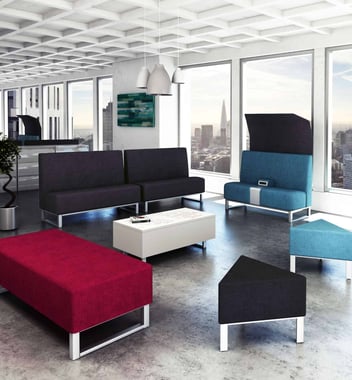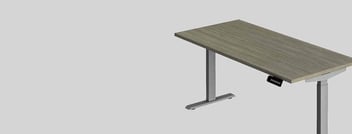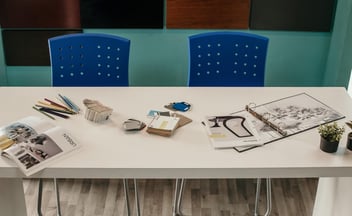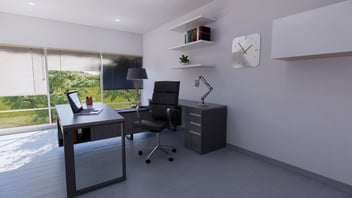How to design your corporate offices?
The design of corporate offices is based on the objectives of the business and the needs of the workers. Learn here how to create them successfully.
Since we spend a lot of time in the office, it has been discovered that an inspiring workspace can motivate us to work better and increase our productivity. To do this, we must consider 3 basic aspects:
- What image/values do you want to convey?
- How can you incorporate the needs of your collaborators into the design?
- How will the design help to improve the company's results?
In this article, we will explain the importance of corporate office design and the key points for developing it successfully. Take note!
The design should focus on the worker
Office interior design cannot ignore an extremely important factor: what is the purpose of the workspace?
Ideally, we want to create offices where our employees feel comfortable and can work better. Therefore, before making plans, buying furniture or renting a place, you should consider:
- What kind of activities will take place in that space?
- How many people will occupy the space and what positions will they hold?
- What kind of work equipment is required?
- Will clients visit the office?
- Do they need to store documents or materials?
In addition, the office design must also offer mobility, sustainability, integrated technology and functionality to make the pace of work more productive.
Benefits of improving your corporate office
The redesign of your office based on the present and forecasted needs of the company helps to retain and attract talent because the new entrants to your workforce, demand modern and pleasant workspaces.
Professionals who decide to invest in the design of their companies by creating attractive, collaborative and inspiring environments have a greater chance of improving their profitability and competitiveness. Will you be left behind or would you rather take the risk?
Corporate image, how does it influence business identity?
Before thinking about the design, the furniture or the decoration of your office, it is necessary to define the identity of the business, that is to say, how does it define itself, how does it want to be recognized, what colors identify it?
The corporate image is the graphic representation of the company's values, mission, and culture. For example, the logo, advertising, communication, style, and decoration.
Let's say that space is the reflection of your organization and every detail of the design of a corporate office, communicates your brand image and helps your customers and partners recognize it.
In a practical case, if a company defines itself as modern, its image must support that concept: modern interior design trends and state-of-the-art work equipment.
Corporate design, how to integrate it in the office?
In essence, the design of your corporate office must be based on the personality of the company, your objectives and the needs of your collaborators. To achieve this, we give you three ideas:
1. Furniture that optimizes space
Something fundamental is to choose the right furniture to use in your office. Take into account that the design, material, and finishes also transmit the identity of the business.
However, there are many types of office furniture, so we recommend that before choosing the most attractive design, consider the strength, adaptability, and functionality they can offer.
For example, if the company represents an innovative and creative product, the ideal would be to furnish the space with minimalist furniture. On the other hand, if you think your staff will grow and you have little space, modular systems are a perfect choice.
2. Attractive colors that increase motivation
Equally important is the color of your office because it can encourage the creativity and productivity of users. However, you can also combine several color palettes according to your corporate image.
You don't have to just paint the walls. You can use other furniture elements such as sofas, carpets or color bookshelves to accentuate the decoration, according to the functions of each department.
Neutral colors such as grey, black, white or brown reflect an institutional image. But, if your company's logo has orange elements, the tone of the walls can be gray or white, which suggests a minimalist style.
3. A decor that harmonizes the environment
During the design of your corporate office, it is also important to know the layout of details and decorative items: lamps, curtains, plants, carpets, tables, etc.. Even the stationery must include the logo or the representative tones of the business.
The decoration must be coherent with the corporate colors, the brand image and what we want to communicate.
Ideally, if the company has a corporate identity manual, it is easier to define the criteria on which to choose each element of the space and verify that they adequately represent the brand image, both internally and externally.
Spaces in corporate offices: characteristics and benefits
The corporate offices are characterized by having a distribution that helps to optimize space. This helps to divide the work stations in an orderly way so that the users work efficiently.
But, not all spaces have the same functions and objectives. For that reason, here we list some characteristics of the different corporate spaces:
Private offices
The private office is a traditional space, whose objective is to offer greater privacy and denote status. Normally, it has the most sophisticated furniture, lots of light and elegant decor.
However, top executives sometimes spend the least time in the office, so these spaces are wasted while decreasing interaction with other staff.
Therefore, the design of the private office is changing to offer more flexibility and improve collaboration, without neglecting acoustic and visual privacy. Through technology and distribution that helps make the most of space.
Meeting rooms
New trends in interior design aim to improve collaboration and boardrooms play a crucial role in this regard.
To get the most out of this space, the key is in the configuration. That is, according to the objective of the meeting, the table and chairs can define hierarchies, leadership, as well as mark the time and dynamics during the day.
A classic configuration has a long rectangular table to establish negotiations or deal with confidential topics; while a block configuration is ideal for a brainstorming session, where users have to interact on collaborative topics.
Common areas
Many companies continue to opt for cubicles, although this design, which seeks worker privacy, also reduces productivity and creativity.
The ideal way to optimize your office is to have shared spaces where workers can interact and exchange ideas. To do this, you can follow these steps:
Identify areas where employees can socialize or be distracted. Perhaps implementing a cafeteria, coworking or terrace is the ideal option.
Identify what kind of noises can distract the worker, both internal and external. Install screens to reduce noise pollution.
Choose different furniture, sofas, swings, reclining chairs, benches, that make users feel more comfortable.
Rest areas
Unlike companies 50 years ago, corporate offices include rest areas for workers, allowing them to clear their minds and return to work more motivated.
The key is to find the balance to reduce staff stress and fatigue, without affecting business productivity.
Dining
Something fundamental is to include dining rooms or coffee break areas where employees can not only supply their food and drink needs, but also socialize with the rest of their colleagues.
The design can include tables of different sizes and heights, ergonomic chairs and sofas; in addition, a good coffee maker can not be missing.
Offices that reflect our brand
The first impression is always what counts. Now, visualize the facade as the face of your office, does it really reflect the style and personality of your company?
It's important that every element of your office (colours, furniture, materials, decoration and distribution) is consistent with the brand image and identity of your business.
Is it a traditional or a modern company? Are you looking for an institutional architecture or a more youthful one? Do you want to expose a serious or fun side? Let's start!






